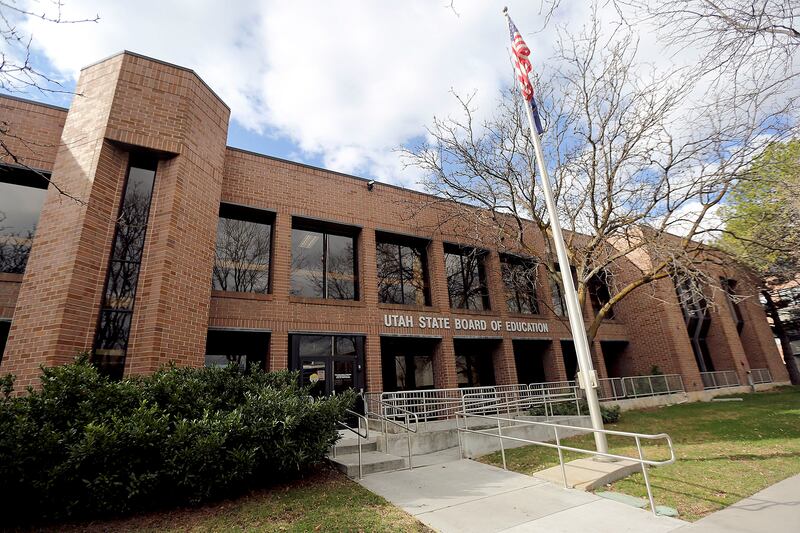More than a dozen parents, educators and community members addressed the Utah State Board of Education Thursday urging the board to adopt a definition of equity and to support teacher training in diversity, equity and inclusion.
Briawna Hugh, the mother of four biracial children and an educator, said Utah is not doing enough to address issues of race and equity.
“We live in a culture that is dominated by a specific ideology. It’s not a bad ideology but it definitely caters to a specific kind of student and a specific kind of family. Since moving here five years ago, our biracial family has been on the receiving end of experiences that range from ignorant comments to flat-out racist actions. When reported to the teachers and administration, they were a loss for how to handle the situations,” Hugh said.
Generally speaking, her children’s teachers and administrators care about them, she said.
“But their failure to show up for my children in those moments of deep hurt tells me that we are not doing enough to address the racial issues in this state,” she said.
Sherilyn Fuhriman, a mother of four from Weber County, described the experiences of her youngest child, who was adopted from the Democratic Republic of Congo.
Some of her son’s teachers have reached out to her family for recommendations on literature and asked their advice how to handle sensitive classroom discussions on the trans-Atlantic slave trade.
“And yet, school is the only place in my son’s 16 years where he has been called the N-word,” she said.
Children need help understanding the value of people’s differences, Fuhriman said.
“They need to learn ways to talk about race out loud and not in whispered profanity,” she said.
Tony Zani, literacy specialist and instructional coach at Salt Lake’s Rose Park Elementary School, said when he started teaching more than 20 years ago, he was told to be “colorblind” and treat everyone the same.
The message was “everyone should be like me,” said Zani.
“At Rose Park, most of our students are students of color and they represent a wonderful variety of cultures. Fortunately for our students, we aren’t trying to be colorblind. We are working to reject racism and to honor every student’s race and culture. Students at Rose Park are more invested in school because the teachers honor the students for exactly who they are,” he said.
While the board took no action on professional development regarding diversity, equity, and inclusion, the matter was referred to the board’s executive committee with a request to assign its Standards and Assessment Committee to develop a proposed board rule.
But the board spent nearly two hours debating the definition of educational equity, largely adopting the recommendation of the standards committee, which suggested using the definition of equity found in the board’s strategic plan.
It states: “Educational equity is the equitable distribution of resources based upon each individual student’s needs to provide equal opportunities. Equitable resources include funding, programs, policies, initiatives and supports that target each student’s unique background and school context to guarantee that all students have access to a high-quality education.”
Members of the board’s Standards and Assessment urged the full board to adopt the definition recommended by the committee.
Board member Jennie Earl offered an alternative, which said, in part, that all students are capable of learning, self-governance, self-improvement and personal responsibility.
Board member Janet Cannon said language such as personal responsibility “invalidates what we’re trying to achieve with equity.”
She questioned why a Navajo student who lives in a home that has no electricity or may not have a clock be held personally responsible if he or she does not arrive on time to school each day.
“I just think that’s the antithesis of what we’re trying to do with defining equity,” Cannon said.
The board is discussing equity because “we have students who have been marginalized in our system and typically these marginalized students are those who come from different cultures, different backgrounds, and we are trying to help and be fair with what our education system offers them,” Cannon said.
Board member Natalie Cline spoke in support of including personal responsibility in the definition.
“We can do everything we can do for them but if they don’t take on personal responsibility for their learning, and it’s like leading a horse to water ... but we can’t make him drink it,” Cline said.
If the public education system provides students every tool and resource and “they don’t exercise personal responsibility, it will all be for naught.
“The last thing you want to do is give kids an excuse to fail or let them think that it was our responsibility to help them be successful. We can only help. We’re only a part of the equation. Without them taking the reins, you know, taking the bull by the horns, they won’t be able to achieve no matter how much we try to help,” she said.
Board member Carol Lear said she had received some 50 emails in support of the standard’s committee definition.
“Every single one of them saying ‘We really liked this definition. We liked the brevity of it. We like the language of it,’” Lear said, explaining she would support the committee’s recommendation.
Ultimately, the board struck language on personal responsibility, self-governance and self-improvement.
The definition approved by the board added this language to the definition, “Acknowledging that all students are capable of learning, educational equity is the equitable distribution of resources based upon each individual student’s needs to provide equal opportunities.”


